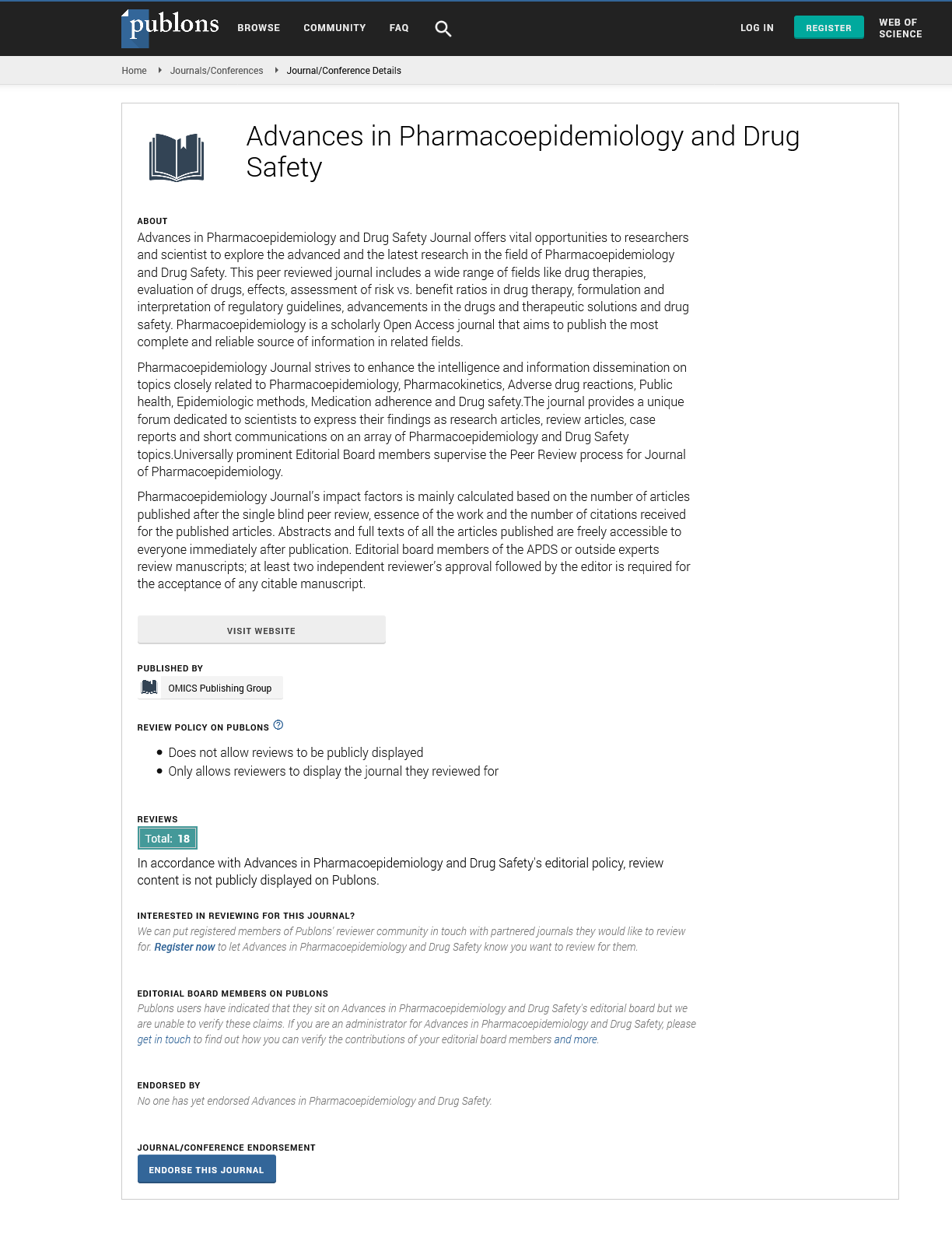Indexed In
- Open J Gate
- Genamics JournalSeek
- Academic Keys
- JournalTOCs
- RefSeek
- Hamdard University
- EBSCO A-Z
- SWB online catalog
- Publons
- Geneva Foundation for Medical Education and Research
- Euro Pub
- Google Scholar
Useful Links
Share This Page
Journal Flyer

Open Access Journals
- Agri and Aquaculture
- Biochemistry
- Bioinformatics & Systems Biology
- Business & Management
- Chemistry
- Clinical Sciences
- Engineering
- Food & Nutrition
- General Science
- Genetics & Molecular Biology
- Immunology & Microbiology
- Medical Sciences
- Neuroscience & Psychology
- Nursing & Health Care
- Pharmaceutical Sciences
Abstract - (2022) Volume 11, Issue 6
Drug Importance in Healthcare and Applications
Qiliang Tan*Received: 27-Oct-2022, Manuscript No. PDS-22-19255; Editor assigned: 31-Oct-2022, Pre QC No. PDS-22-19255 (PQ); Reviewed: 15-Nov-2022, QC No. PDS-22-19255; Revised: 22-Nov-2022, Manuscript No. PDS-22-19255 (R); Published: 29-Nov-2022, DOI: 10.35248/2167-1052.22.11.287
Description
A drug beneficial effect for the human body to cure the diseases, such as: Lower blood pressure, cures infections, or relieves pain. A drug's risk is the potential for unwanted or unexpected events to occur when using it. Taking medications is an integral part of everyday life for many people, and these medications are used to treat illness and improve health. Medications can help the feel better, but be aware that both prescription and over-the-counter medications have both risks and benefits, such as lowering blood pressure, treating infections, and relieving pain. It is important to note that the risk of any drug is the potential for unwanted or unexpected events to occur when using it. Risks may be less severe, such as: Stomach upset, or something more serious. Here are some tips from the Food and Drug Administration and some of its public health partners to help weigh the risks and benefits when making decisions about which drugs to use. Centers for Disease Control and Prevention (CDC) estimates that 30-50% of chronic disease medical errors and 125,000 deaths each year in this country are non-compliance. 25-50% of people taking statins (cholesterol-lowering drugs) who stop taking them within a year have an increased risk of death of up to 25%. The search terms used were drug safety, patient safety, drug interactions, pharmacokinetics, and adverse drug reactions. All retrieved abstracts were evaluated in the context of evaluative purposes. This study excluded studies in languages other than English. All drugs have side effects, but the magnitude and severity of the effects range from mild (such as mild itching and mild headache) to severe (severe skin rashes, and to vital organs (mainly the liver and kidneys). injury, and possibly even death. Most side effects are predictable and documented in each drug's package insert. A serious problem, however, is that some of the drug's side effects were previously unknown or unnoticed, and the actual risk is whether they have serious adverse effects on the patients who use them. Number of the factors that can increase the severity of side effects, the type of drug and the type of patient using it are the most important.
Drug safety is the main aspect of medical therapy that can play a major role in deciding which drug should be given to a patient. Also, considering the concept of benefit–risk balance, we found that drugs with a high risk profile should be avoided unless needed. Drug safety has gone through different stages from the last century and till now and there have been several tragedies that we should learn from to protect our patients. All patients should be protected; nevertheless, specific groups of patients should be given more care, such as pregnant women, children, and the elderly, since they are considered vulnerable populations. Drugs can react with other drugs or foods used on a daily basis and specific precautions are required to avoid these simple but dangerous interactions. However, the risks from medications could be minimized through patient education about drug safety and openness with the patient, allowing him/her to ask questions related to their disease or medications. A good relationship between the medical team and the patient is one of the most important determinants for drug safety.
Drug safety is a major aspect of medical therapy that can play an important role in deciding which drugs to administer to patients. Furthermore, considering the concept of balancing benefits and risks, we found that drugs with high risk profiles should be avoided unless necessary. Drug safety has gone through many stages over the past century to the present, but there have been some tragedies to learn to protect patients. All patients must be protected. Nonetheless, certain patient groups such as pregnant women, children and the elderly are considered vulnerable populations and should be better cared for. It can react with food and requires special precautions to avoid these simple but dangerous interactions. However, educating patients about drug safety and being open to asking questions about their disease and drugs can minimize drug risks. A good relationship between the medical team and patient is one of the most important factors in drug safety.
Citation: Tan Q (2022) Drug Importance in Healthcare and Applications. Adv Pharmacoepidemol Drug Saf. 11:287.
Copyright: © 2022 Tan Q. This is an open-access article distributed under the terms of the Creative Commons Attribution License, which permits unrestricted use, distribution, and reproduction in any medium, provided the original author and source are credited.

